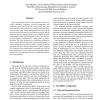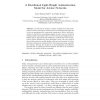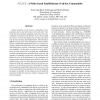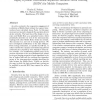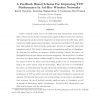WICSA
2004
14 years 24 days ago
2004
Research domains such as active networks, ad-hoc networks, ubiquitous computing, pervasive computing, grid computing, and sensor networks, clearly show that computer networks will...
ICISC
2001
14 years 25 days ago
2001
Abstract. In this work we present a security model for low-value transactions in ad-hoc networks in which we focus on authentication since this is the core requirement for commerci...
CNIS
2006
14 years 25 days ago
2006
There are many essential applications for quorum systems in ad-hoc networks, such as that of location servers in large-scale networks. Existing research proposes many approaches t...
MMS
2007
14 years 26 days ago
2007
Abstract: For evaluating dynamics of mobile ad-hoc networks at least three different layers have to be distinguished: the application layer, the protocol layer, and the network lay...
CNSR
2004
IEEE
14 years 3 months ago
2004
IEEE
An ad-hoc network is formed when a group of wireless nodes pledge to help each other in passing packets based upon a pre-agreed protocol. Temporally Ordered Routing Algorithm (TOR...
ACSC
2004
IEEE
14 years 3 months ago
2004
IEEE
An ad-hoc network of wireless nodes is a temporarily formed network, created, operated and managed by the nodes themselves. It is also often termed an infrastructure-less, self-or...
ACSC
2004
IEEE
14 years 3 months ago
2004
IEEE
An ad-hoc network comprises mobile nodes that cooperate with each other using wireless connections to route both data and control packets within the network. As the low transmissi...
ACSAC
2004
IEEE
14 years 3 months ago
2004
IEEE
Ad-hoc networks are perceived as communities of autonomous devices that interconnect with each other. Typically, they have dynamic topologies and cannot rely on a continuous conne...
SIGCOMM
1994
ACM
14 years 3 months ago
1994
ACM
An ad-hoc network is the cooperative engagement of a collection of Mobile Hosts without the required intervention of any centralized Access Point. In this paper we present an inno...
ICDCS
1998
IEEE
14 years 3 months ago
1998
IEEE
Ad-hoc networks consist of a set of mobile hosts that communicate using wireless links, without the use of other communication support facilities (such as base stations). The topo...
